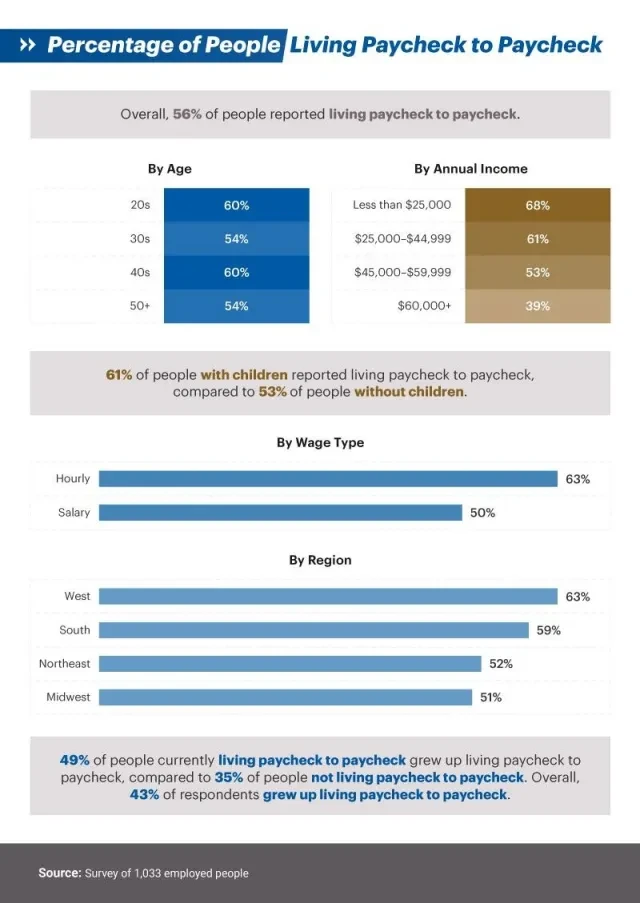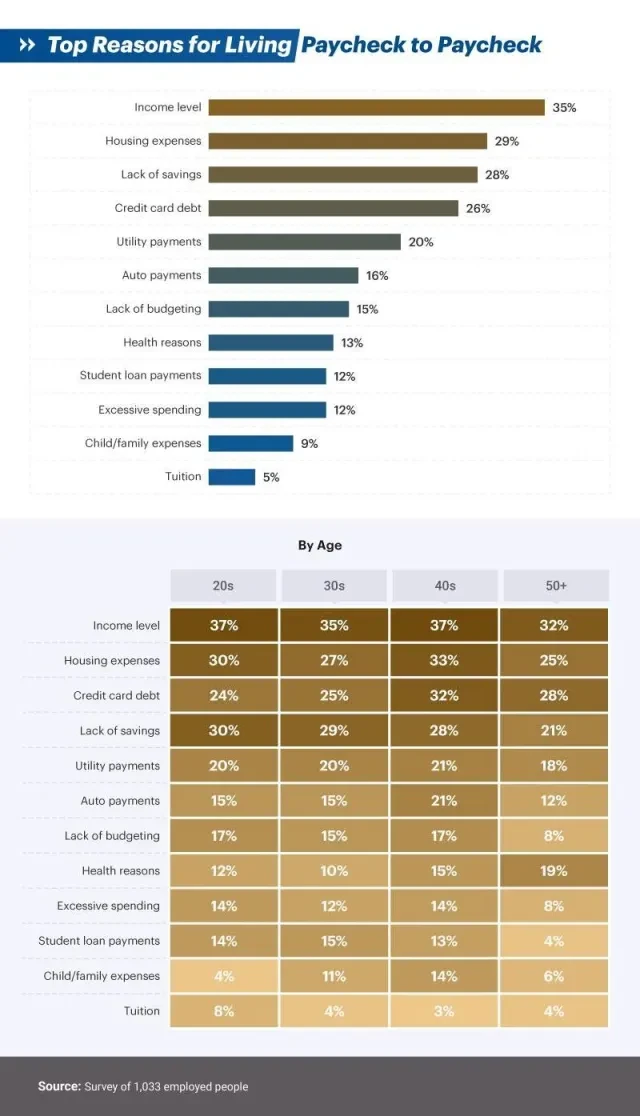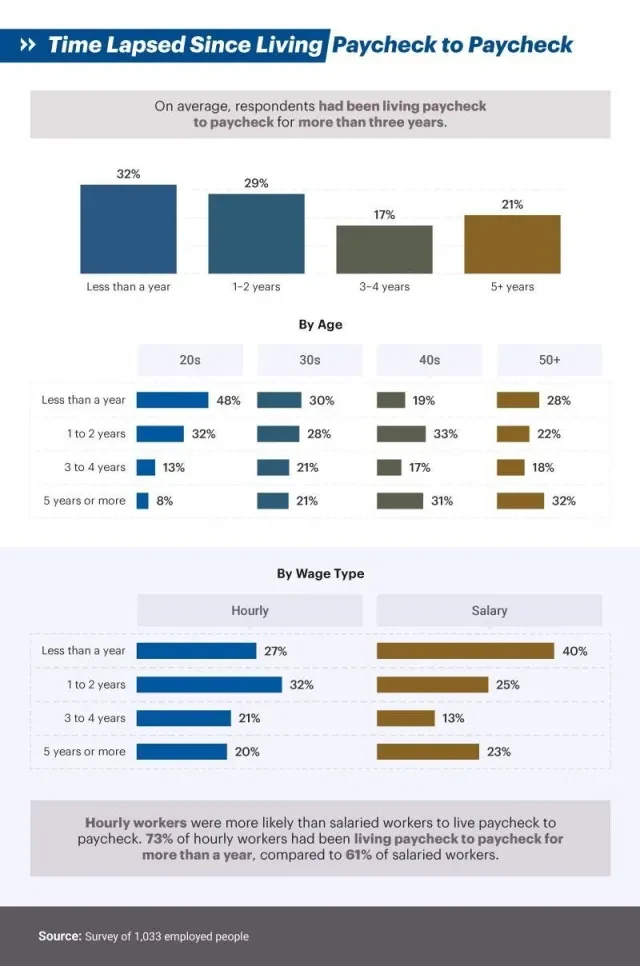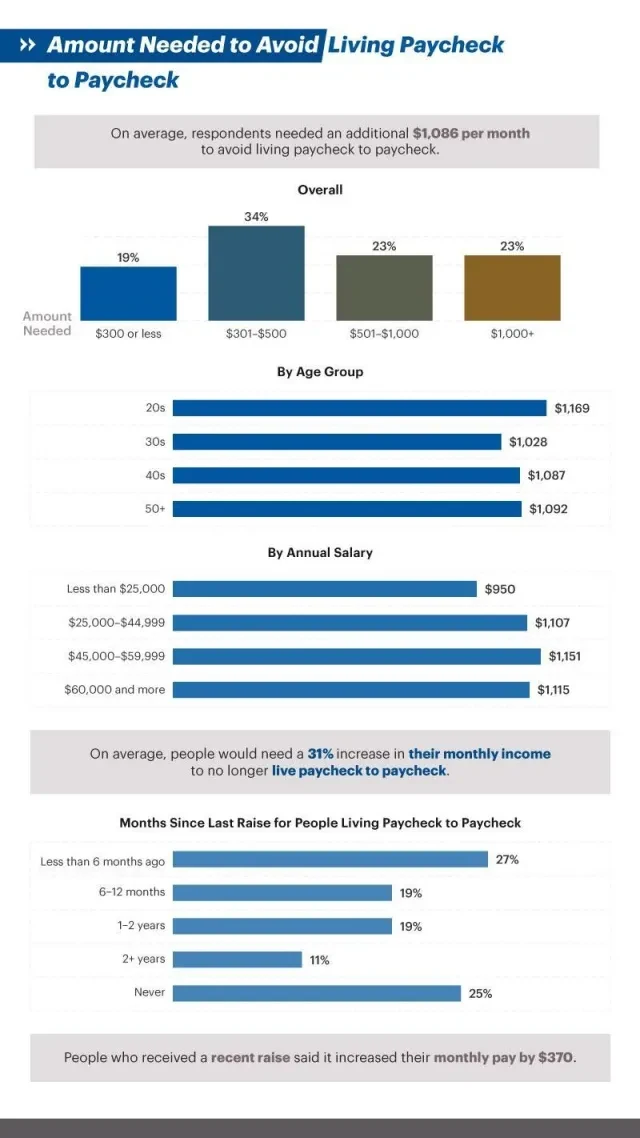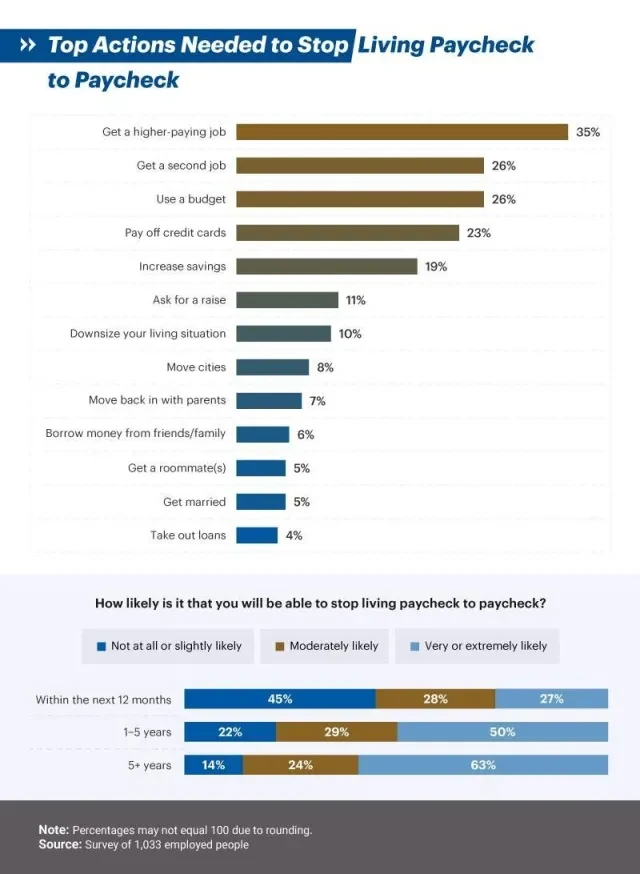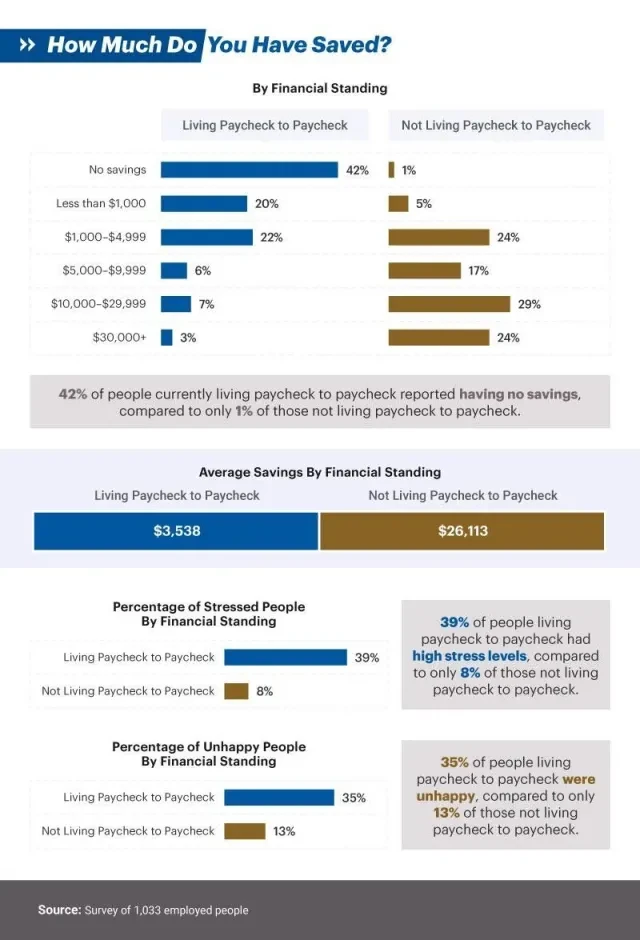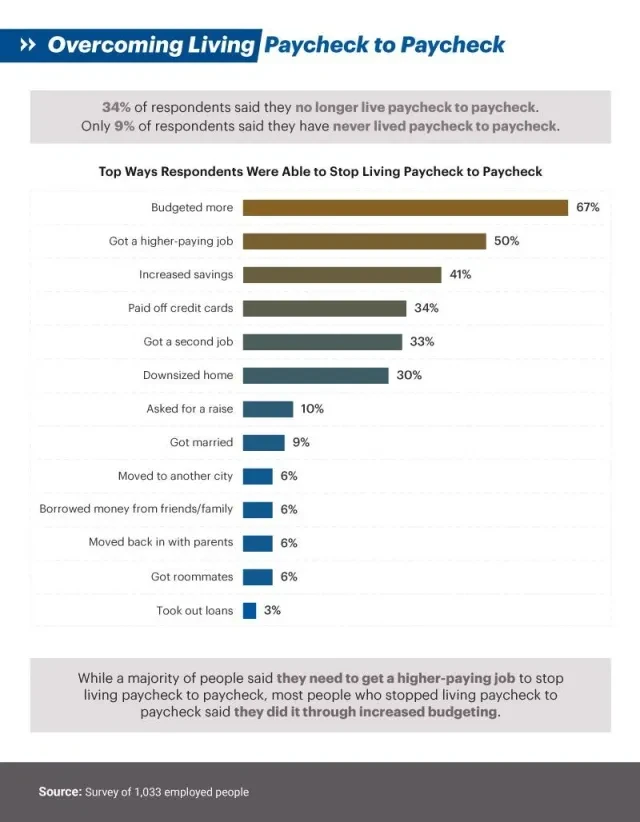- Recursos humanos
- Lectura de 6 minutos
- Last Updated: 07/16/2020
Living Paycheck to Paycheck

Table of Contents
Since March 2020, following the COVID-19 outbreak, 33.5 million Americans have filed for unemployment as a result of layoffs, and there have been far-reaching industry impacts due to social distancing. If you’ve been impacted, your regular source of income could be severely disrupted: Your paychecks may be a fraction of what you’re used to, or perhaps they’re gone altogether. Or maybe you have a massive, unexpected expense to manage on top of all your other bills. Emergencies aren’t something most people plan for, but experts recommend having a minimum of three to six months’ worth of living expenses set aside in case things turn upside down.
Preparing for a crisis can be exceptionally difficult, however, if you count on each paycheck to make ends meet. In fact, 40% of Americans don’t have enough cash to cover a $400 unexpected expense, which can make managing even the smallest financial turbulence seem impossible.
For a closer look at how many Americans live paycheck to paycheck, we surveyed 1,033 working people about their monthly finances, including savings and spending. Read on as we discover who’s most likely to rely on each paycheck, how long this financial tightening may last, and the actions people believe they could take to make a major change.
Counting on Every Dollar
Millennials may have a reputation for their financial decisions, but they aren’t the only generation who reported living paycheck to paycheck. More than half of Americans polled relied on payday to get by, led by 60% of people in their 20s and 60% of people in their 40s. Fifty-four percent of people in their 30s and just as many of those aged 50 and older reported the same. A report by the Pew Research Center indicates young workers may be disproportionately affected by the impact of COVID-19 on the restaurant and service industry.
What can trigger this widespread reliance on payday to afford our everyday expenses? Paycheck-to-paycheck scenarios were more common among those working hourly jobs (63%) compared to salaried positions (50%), and higher among Americans with two or more children (61%) than just one child (60%) and no children (53%).
While just over 1 in 3 Americans earning $60,000 and more annually reported depending on every paycheck, those earning less than $25,000 were much more likely to rely on payday (68%), followed by those earning between $25,000 and $44,999 (61%).
Region and rearing can also have an impact on living paycheck to paycheck. Americans in the West (63%) were more likely than those living in other parts of the country, including the Northeast (52%) and Midwest (51%), to live paycheck to paycheck. Similarly, nearly half of Americans living paycheck to paycheck grew up in the same financial situation, compared to 35% who managed to break the cycle.
Monetary Deficiency
Living paycheck to paycheck might be common among Americans, but their reasons for tight finances aren’t always the same. While more than 1 in 3 indicated income level contributed to their financial struggle, housing expenses (29%), lack of savings (28%), and credit card debt (26%) were also common explanations.
Americans in their 20s and 40s were the most likely to specify income level and housing expenses as reasons for living paycheck to paycheck. Those in their 40s were also the most likely to say credit card debt (32%), utility payments (21%), and auto payments (21%) were reasons they didn’t have any cash left over. Thirty percent of those in their 20s and 29% of people in their 30s pointed to a lack of savings to explain their dependence on paychecks.
Overcoming Financial Hardship
While roughly 1 in 3 Americans found themselves living paycheck to paycheck for less than a year, the average respondent reported strained finances for more than three years. Another 1 in 5 reported relying on their paychecks to make ends meet for five years or more.
Younger generations typically experienced tighter finances for less time overall. Nearly half of those in their 20s reported relying on each paycheck for less than a year, and another 1 in 3 only lived paycheck to paycheck for one to two years. Compared to around 1 in 5 people in their 30s depending on each paycheck for five years or more, 31% of those in their 40s and 32% of those aged 50 and older said the same. Salaried employees (40%) were also more likely to live paycheck to paycheck for less than a year compared to those earning hourly compensation (27%), although they were nearly equally likely to live that way for five years or more.
Breaking the Cycle
Despite so many years, and, in some cases, generations, living paycheck to paycheck, we found that the gap between barely getting by and a more comfortable financial situation wasn’t as wide as you might expect. On average, Americans reported needing an additional $1,086 per month to avoid completely exhausting their income. Another 1 in 3 needed even less, between $301 and $500, and 19% needed $300 or less to forgo living paycheck to paycheck.
The youngest people polled, those in their 20s, reported needing the most to create breathing room between their paychecks, $1,169 on average. Respondents in their 30s reported needing the least to climb out of their financial situation ($1,028).
Those earning less than $25,000 a year needed just $950 to break the cycle, while those earning $60,000 and more needed $1,115, on average, to do the same.
Taking Matters Into Their Own Hands
Even if they can’t make an immediate change, a majority of Americans surveyed believe they’ll be able to get out of their financial situation eventually. While 27% of respondents believed it was extremely or very likely they’d stop living paycheck to paycheck within the next 12 months, people were more confident that they’d be out of this situation within the next one to 5 years. But, 63% of respondents said it was very or extremely likely it would take them more than 5 years to get out of living paycheck to paycheck.
When asked what would make the biggest impact in overcoming living paycheck to paycheck, 35% pointed to a higher-paying job, followed by a second job and budgeting more (26% each). Budgeting can be intimidating, but it can help you identify poor spending habits and plug the leaks that could be draining your income. Just 1 in 10 Americans believed downsizing their living situation would help them stop living paycheck to paycheck.
Bridging the Savings Gap
Establishing a savings account could be the secret weapon against living paycheck to paycheck. While roughly 1 in 5 people indicated increasing their savings would help them break the cycle, 42% of people living off each paycheck reported having no savings, compared to just 1% of those not living paycheck to paycheck.
Among those waiting for payday, average savings were roughly $3,500, compared to those not depending on each paycheck to get by who had around $26,000 in savings. With the weight of monthly obligations, Americans living between checks were 31 percentage points more likely to indicate feeling stressed and 22 percentage points more likely to be unhappy.
Leading by Example
Budgeting and saving may not seem like the quickest ways to stop living paycheck to paycheck, but they may ultimately be the most successful methods. More than 2 in 3 people who’d lived paycheck to paycheck managed to break the cycle by budgeting. Half said the same about getting a higher-paying job, followed by increasing savings (41%) and paying off credit cards (34%).
While just 1 in 10 Americans believed downsizing their living situation would help their finances, 30% of people who stopped living for the next payday did so by decreasing their living expenses and cutting back on their overall cost of living.
Protecting Your Employees
No matter the size of your business, you may have employees who are living paycheck to paycheck. And while a path forward could be additional income or a higher-paying job, budgeting and saving were tactics that helped a majority of respondents stop living paycheck to paycheck.
At Paychex, we’re committed to helping you and your employees. At Paychex, we offer our customers access to financial wellness tools for their employees. FinFit not only offers financial education and budgeting apps, but also loans for emergencies and the unexpected. Giving them the tools to manage their money means they’ll have the resources they need to make it go further and further every month. Learn more at Paychex.com today.
Methodology
We surveyed 1,033 people over the period of February 27-28, who are currently employed. 583 people lived paycheck to paycheck, and 450 did not. We had 489 women and 517 men take this survey, and the remaining respondents did not identify as male or female. We used the Amazon Mechanical Turk service to source our respondents. This survey is not representative of the entire population and isn’t weighted. The information presented in this survey is based on self-reporting, and because of this, there are limitations, such as over- or under-reporting on values. Any outliers were excluded from write-in options on values for this survey.
The age group counts are as follows:
50+: 175
40s: 204
30s: 38
20s: 255
Fair Use Statement
Want to help your readers understand there’s more to finances than earning a bigger paycheck? Share the findings of this study for any noncommercial use with a link back to this page so that they have full access to our findings.
Tags

